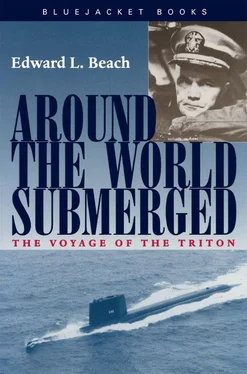Prior to the test, Tom Thamm sought me out.
“Captain,” he said, “my calculations show us to be pretty heavy by the time you consider the reduced salinity and the changes which have taken place in our internal weights.”
“Yes?” I said.
“According to these figures we ought to pump out about seventy thousand pounds before we have the drill …”
“Tom,” I interrupted, “aren’t your Diving Officers and Diving Chiefs keeping up with the trim as we go along?”
“Yes, sir, but I made a special computation because of this drill coming off, and that is what the figures show.”
This would be an opportunity for a good lesson, I thought. “Permission not granted, Tom,” I said. “The sort of casualty that we’re simulating might happen at any time, and we would have to face it with the conditions existing at that time. Suppose we really were to lose all power right now, rather than an hour from now after you get all this water pumped out?”
I had Tom there and he knew it, though I could see that he did not fully approve. “Aye aye, sir,” he said. “I’ll stand by in the control room just in case.”
I grinned at him. Tom was a perfectionist who didn’t want to have anything go wrong in his department. If the ship were too badly out of trim, a short blast of high-pressure air in the main ballast tanks was the quickest way of expelling a lot of water and stopping her descent. Then, the air in the tanks would have to be vented off—partly, at least—as we came up. Otherwise, with reduced external pressure as the ship rose to shallower depths, the air in the tanks would expand even more, thus still further lightening her. Blowing precisely the right amount to balance exactly could not be guaranteed, and several blowings and ventings would undoubtedly be required before the trim pump could get rid of enough water. And later, Curt Shellman’s carefully tended air compressors would have to perform considerable extra work to recharge the air banks.
In the unlikely event that Tom was wrong, that the ship was light instead of heavy, water would have to be taken in rapidly in order to keep her from broaching surface; but with the aid of sea pressure, this is always a much easier thing to do than to pump it out.
The particular problem that faced us had almost never been experienced in battery-driven submarines, for these normally operate at minimum speed while submerged in order to conserve their vitally important batteries, and any divergence from a perfect submerged trim is instantly evident. As a consequence, all old-fashioned submarines automatically stay in perfect trim, practically as a reflex action, whenever they operate submerged. Being even slightly out of trim causes difficulty in maintaining depth at slow speed. But at our sustained high speed, a few hundred tons of extra weight, or buoyancy, would be unnoticeable—until we slowed down.
Everyone in the ship was up and around during the drill period, late-sleepers among the off-watch section having been jolted into consciousness by the daily test of the ship’s various alarm systems, which had been programmed for fifteen minutes prior to the beginning of the exercise.
At the agreed-upon time, I, too, was in the control room, as were Will Adams and Tom Thamm. At my signal, Will picked up the telephone and spoke briefly to Don Fears, who, naturally enough, just happened to be in number one engine room.
Immediately, a strident voice bellowed on the ship’s general announcing system. “Control, this is Maneuvering One. We’ve lost all power, both shafts.”
I watched the engine-order telegraph indicators on the Diving Control Panel shift swiftly from “ahead full” to “stop.”
For a moment, nothing else happened, though I knew our propellers were now only pinwheeling with the ship’s motion through the water. Dick Harris, who had the Diving Officer’s watch, stepped a few inches closer to his planesman; all three were intently scanning the instruments in front of them. Seated on the padded tool box in front of the fathometer, Tom Thamm was doing the same, while two feet farther aft, Chief Engineman E. C. Rauch had squared himself away in front of his Diving Panel and crushed out his half-smoked cigarette.
Elsewhere in the ship, wherever there was a critical station, I knew that the men on watch were standing by to take whatever action might be necessary, and because this was a scheduled drill, at every station there also stood, as observers, the off-watch personnel, the senior petty officer in charge, and the officer responsible.
We had been making just under twenty knots. As the ship slowed, I knew that both Dick and Tom were watching the depth gauges and the plane-angle indications for the first sign that we were, as everyone suspected, considerably heavier than the water we displaced. We waited a long minute, as Triton slowed and her bow and stern planes gradually lost effect. Suddenly, Harris reached his hand out behind him, motioned toward Rauch. “Pump auxiliaries to sea!” he snapped.
I had not seen yet any indications of the ship’s being heavy. “How do you figure we’re heavy, Dick?” I asked.
“Mostly intuition I guess, Captain,” he replied. “There’s really no sign here yet, but I know darned well she’s heavy.”
Another minute passed. We had slowed perceptibly and now it became evident that to hold the ordered depth, the planesmen were required to maintain up angle on both bow and stern planes.
“We are heavy, all right,” I said.
From Harris my response was a tight-lipped smile, but it was Third Class Quartermaster Roger A. Miller, standing watch on the bow planes, who put it into words with a deep-toned whisper which caromed off the deck and bulkheads and brought amused smiles to everyone within earshot.
“This old hog sure has lead in her ass!” said he, as he lifted the bow planes another five degrees.
As speed dropped off rapidly, bow and stern planes soon were at the maximum angles of elevation and then, inexorably, Triton began to sink. In the meantime, Rauch, checking the rate-of-flow meter, was monotonously calling out the amount of water we pumped overboard: “5,000 out—7,000 out—10,000 out, sir—12,000 out—15,000 out.”
Dick made no motion to stop him. Triton’ s speed through water had by now dropped to only three or four knots; she was still on an even keel, but the depth gauges were showing a gradually increasing speed of descent.
It was apparent soon that we should not be able to get enough water out of the ship before she had exceeded the maximum depth to which we were allowed to submerge her. Deliberately I waited as long as possible, then finally nodded to Dick, “I guess we won’t be able to catch her, Dick. Blow tanks.”
“Blow forward group! Blow after group!” Dick had the orders ready.
So did Rauch, whose fingers were already on the main ballast blow valve switches. With two quick motions, high-pressure air was roaring into Triton’ s main ballast tanks. Dick waited until he saw our downward motion perceptibly reduced, then gave the clenched fist signal to Rauch at the same time as the order, “Secure the air!”
The noise of air blowing stopped. We had lightened the ship by several hundred tons, and Triton’ s involuntary dive stopped well above the allowed limit. But this was not the end of the episode.
The depth gauges now started going in the other direction. Triton was rising to the surface, slowly at first and then with increasing speed. We had placed a large air bubble in our main ballast tanks which, like uncorked bottles inverted in the water, were open at the bottom and closed at the top. It was impossible to gauge the amount of air that had to be blown into the tanks so as to put the ship precisely and exactly in equilibrium at a given depth.
Читать дальше












